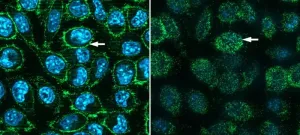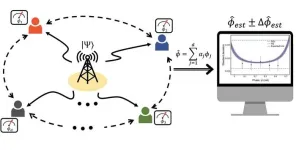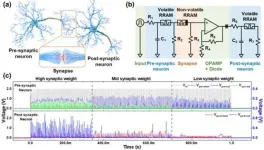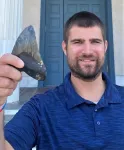(Press-News.org)
Electrical impedance tomography (EIT) is a non-destructive imaging technique used to visualize the interior of materials. In this method, an electric current is injected between two electrodes, creating an electric field, and other electrodes measure distortions caused by the presence of foreign objects inside the material. Compared to other imaging methods, such as X-ray imaging, computed tomography, and magnetic resonance imaging, EIT has the advantages of being low cost and less cumbersome as it does not require large magnets or radiation. Therefore, it holds great potential as a non-destructive structural health monitoring method for intricate and complicated cement-based building materials.
The challenge with EIT, however, lies in accurately reconstructing the obtained information as images. Algorithms like one-step Gauss-Newton, primal dual interior point method, and iterative Gauss-Newton (IGN) are typically used for this purpose. However, due to the nature of EIT, the solutions obtained using the above mathematical methods contain some inaccuracies. Recently, to overcome this issue, machine learning algorithms such as one-dimensional convolutional neural networks (1D-CNN) have been used. However, the weakness of these algorithms lies in handling previously unseen data, which reduces their effectiveness.
To address the above challenges, Associate Professor Takashi Ikuno from the Tokyo University of Science (TUS), along with his collaborators, Mr. Keiya Minakawa, Mr. Keigo Ohta, and Mr. Hiroaki Komatsu from TUS and Associate Professor Tomoko Fukuyama from Ritsumeikan University, all from Japan, has now developed a novel hybrid EIT approach, called AND, which combines the benefits of IGN and 1D-CNN. When the cross-sectional area ratio of the foreign body to the sample was 5x10-4 (very small foreign body), the present approach reduced the size error to less than 1/6th of that of the conventional EIT method. Their findings were published in Volume 14, Issue 1 of the journal AIP Advances on 12 January 2024.
“From the perspective of disaster prevention, deterioration analysis of existing structures built during the period of high economic growth is important. Our new method can improve the application of EIT as a non-destructive testing method and contribute to preventing building collapses,” says Dr. Ikuno.
The innovative AND method performs 2D logical operations on multiple images obtained from EIT to detect small foreign objects inside materials. In their study, the team tested their AND method on actual cement samples using both simulation and experimental data, comparing its performance to that of IGN and 1D-CNN methods in both scenarios. When using simulation data, they found that the IGN method led to large errors in the reconstructed images as the size of foreign objects decreased. In contrast, the AND method reconstructed the position and size of the foreign objects more accurately than both IGN and 1D-CNN.
Moreover, with experimental data, the researchers found that both the proposed AND method and the 1D-CNN method were more accurate than IGN. In addition, they also identified another method to improve the accuracy of EIT. Dr. Ikuno explains: “One approach to improve EIT is to change the current injection pattern. By changing the spatial distribution of the electric field and by combining the present approach with other NDE techniques, the resolution for detecting the size and position of foreign particles can be improved.” This is the focus of their future research.
“The proposed EIT reconstruction method, while inferior to other NDEs in terms of resolution, has advantages in terms of equipment size and cost. It can lead to improved non-destructive foreign object detection, enabling easier and more regular assessment of building health. It could also be deployed for rapid safety screening after an earthquake or explosion. Furthermore, it is expected to be easy to train inspectors and personnel to use this technology,” concludes Dr. Ikuno, emphasizing the importance of the innovation.
Overall, these findings mark a significant step forward in EIT technology, which could become an important detection technique for preventing building collapse in the future.
***
Reference
DOI: https://doi.org/10.1063/5.0185371
About The Tokyo University of Science
Tokyo University of Science (TUS) is a well-known and respected university, and the largest science-specialized private research university in Japan, with four campuses in central Tokyo and its suburbs and in Hokkaido. Established in 1881, the university has continually contributed to Japan's development in science through inculcating the love for science in researchers, technicians, and educators.
With a mission of “Creating science and technology for the harmonious development of nature, human beings, and society," TUS has undertaken a wide range of research from basic to applied science. TUS has embraced a multidisciplinary approach to research and undertaken intensive study in some of today's most vital fields. TUS is a meritocracy where the best in science is recognized and nurtured. It is the only private university in Japan that has produced a Nobel Prize winner and the only private university in Asia to produce Nobel Prize winners within the natural sciences field.
Website: https://www.tus.ac.jp/en/mediarelations/
About Associate Professor Takashi Ikuno from Tokyo University of Science
Takashi Ikuno received his Ph.D. degree from Osaka University, whereupon he worked at the Lawrence Berkeley National Laboratory and UC Berkeley, USA, as a postdoctoral researcher and later at Toyota Central R&D Labs as a senior researcher. He currently works as an Associate Professor in the Department of Applied Electronics at Tokyo University of Science (TUS), Japan. His research interests include developing electronic devices with nanocarbon and low-dimensional nanomaterials. He can be reached at tikuno@rs.tus.ac.jp.
Funding information
This study was financially supported by the AGC Foundation.
END
(COLUMBUS, Ohio) – A new study conducted by researchers at the Center for Injury Research and Policy of the Abigail Wexner Research Institute at Nationwide Children’s Hospital and the Central Ohio Poison Center investigated trends in calls to poison centers across the country for exposures to liquid laundry detergent packets. The study investigators identified declines in the number, rate and severity of liquid laundry detergent packet exposures among children younger than 6 years. However, the exposure burden remained high. Additionally, exposures have increased among older children, teens and adults.
The study, published in Clinical Toxicology, found that in the most recent ...
Photos
A new University of Michigan-led international study finds that fruits and vegetables grown in urban farms and gardens have a carbon footprint that is, on average, six times greater than conventionally grown produce.
However, a few city-grown crops equaled or outperformed conventional agriculture under certain conditions. Tomatoes grown in the soil of open-air urban plots had a lower carbon intensity than tomatoes grown in conventional greenhouses, while the emissions difference between conventional and urban agriculture vanished for air-freighted crops like asparagus.
"The exceptions revealed by our ...
UPTON, NY—A team of scientists at the U.S. Department of Energy’s (DOE) Brookhaven National Laboratory and Columbia University has demonstrated a way to produce large quantities of the receptor that SARS-CoV-2, the virus that causes COVID-19, binds to on the surface of human cells. That binding between the now-infamous viral spike protein and the human “ACE2” receptor is the first step of infection by the virus. Making functional human ACE2 protein in mouse cells gives scientists a new way to study these receptors and potentially put them to use. In addition, as described in a paper just published in the journal Virology, the ...
Computer science researchers have developed a new way to identify security weaknesses that leave people vulnerable to account takeover attacks, where a hacker gains unauthorized access to online accounts.
Most mobiles are now home to a complex ecosystem of interconnected operating software and Apps, and as the connections between online services has increased, so have the possibilities for hackers to exploit the security weaknesses, often with disastrous consequences for their owner.
Dr Luca Arnaboldi, from the University of Birmingham’s School of Computer Science, explains: “The ruse of looking over someone’s shoulder to find out their PIN is well known. ...
Because low-risk prostate cancer is unlikely to spread or impact survival, experts and guidelines recommend active surveillance, which involves regular monitoring and thus avoid or delay treatment like surgery or radiation therapy and their life-changing complications. A new study examined the rates of active surveillance use and evaluated the factors associated with selecting this management strategy over surgery or radiation, with a focus on underserved Black patients who have been underrepresented in prior studies. The findings are published by Wiley online in CANCER, a peer-reviewed journal of the American Cancer Society.
For the study, called the Treatment ...
Researchers at Linköping University, Sweden, have developed a new, more environmentally friendly way to create conductive inks for use in organic electronics such as solar cells, artificial neurons, and soft sensors. The findings, published in the journal Nature Communications, pave the way for future sustainable technology.
Organic electronics are on the rise as a complement and, in some cases, a replacement to traditional silicon-based electronics. Thanks to simple manufacturing, high flexibility, and low weight combined with the electrical properties typically associated with traditional semiconductors, it can be useful for applications such as digital displays, energy storage, ...
As young people increasingly have access and exposure to online gambling, only one in four parents say they have talked to their teen about some aspect of virtual betting, a national poll suggests.
But over half of parents aren’t aware of their state’s legal age for online gambling and one in six admit they probably wouldn’t know if their child was betting online, according to the University of Michigan Health C.S. Mott Children’s Hospital National Poll on Children’s Health.
“Teens and young adults may have a difficult time going ...
We've all had the experience of trying to get the exact time of a highly competitive concert ticket or class beforehand. If the time in Seoul and Busan is off by even a fraction of an hour, one will be less successful than the other. Sharing the exact time between distant locations is becoming increasingly important in all areas of our lives, including finance, telecommunications, security, and other fields that require improved accuracy and precision in sending and receiving data.
The Korea Institute of Science and Technology (KIST) announced that Dr. Hyang-Tag Lim and his team at the Center ...
With the emergence of new industries such as artificial intelligence, the Internet of Things, and machine learning, the world's leading companies are focusing on developing next-generation artificial intelligence semiconductors that can process vast amounts of data while consuming energy efficiently. Neuromorphic computing, inspired by the human brain, is one of them. As a result, devices that mimic biological neurons and synapses are being developed one after another based on emerging materials and structures, but research on integrating individual devices into a system to verify and optimize them ...
A new study shows the Megalodon, a gigantic shark that went extinct 3.6 million years ago, was more slender than earlier studies suggested. This finding changes scientists’ understanding of Megalodon behavior, ancient ocean life, and why the sharks went extinct.
The Megalodon or megatooth shark is typically portrayed as a super-sized monster in popular culture, with recent examples in the sci-fi films “The Meg” (2018) and “Meg 2: The Trench” (2023). Previous studies assume that the shark likely reached lengths of at least 50 feet and possibly as much as 65 feet.
However, the Megalodon is largely known only from its teeth and vertebrae in the ...







